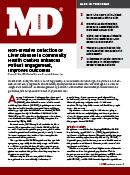Sickle Cell Disease Linked to Vitamin D Deficiency, Low Bone Marrow Density
The assessed sickle cell population had high rates of low vitamin D levels and bone marrow density, but there was no strong correlation between both conditions.

Findings from a new study showed children with sickle cell disease have increased rates of vitamin D deficiency and low bone marrow density. The investigators suggested that such patients should be screened for vitamin D levels regularly.
In this cross-sectional study, a team led by Mohamed Ahmed Badr, MD, from Zagazig University, Egypt sought to assess the relationship between vitamin D levels and bone marrow density in children with sickle cell disease.
Previous literature has suggested a higher risk of bone disease in the sickle cell disease population, and yet little has been known about bone marrow density in such patients and any potential association with 25(OH)D levels.
Therefore, the investigators enrolled a total of 30 patients—53,3% of whom were male—who had sickle cell disease and were regularly following up at the Pediatric Hematology outpatient clinics of Zagazig University Hospitals. The ages of the patients ranged from 6-18 years.
Of the entire population, a majority (60%) of the population had sickle cell anemia, followed by an equal distribution of sickle anemia plus B-thalassemia (20%) and the sickle cell trait (20%).
They excluded patients with known conditions affecting growth or nutritional status, chronic liver and kidney function abnormalities, who were undergoing treatment with drugs that affected the skeleton and bone density, or who had other hemoglobinopathies.
The study was conducted from February 2018 to August 2018.
Vitamin D insufficiency was defined as a 25(OH)D of 21-29 ng/mL.
Further, bone mineral density was measured using the dual-energy X-ray absorptiometry (DEXA) scan. The investigators measured bone mineral density at the posterior-anterior spine, thus adhering to the International Society for Clinical Densitometry (ISCD) recommendation for children.
The results of the DEXA scan were expressed with a Z-score, which is the number of standard deviations from the mean bone marrow density compared with other children of the same age, sex, and ethnicity. Z-scores below -2 SD were considered abnormal, and scores between -1 and -2 were considered low or osteopenia.
Thus, Badr and colleagues found that bone marrow density of lumbar vertebrae 1 – 4 was abnormal in 86.5% of all patients (mean Z-score, -2.33).
Total body bone marrow density was abnormal in 80.0% of the population (Z-score, -1.45).
They also noted that the mean vitamin D level among the entire group was 16.22 ng/mL, with a range from 7.71 ng/mL – 33.68 ng/mL. Additionally, 83.3% of the population had a Vitamin D deficiency.
Of those with sickle cell anemia, 88.9% had a deficiency, followed by a deficiency in 100% of the sickle cell anemia plus thalassemia population (P < .05).
And finally, they found no significant correlation between Z-score of bone marrow density (L1-L4 and total body) and Vitamin D level among the studied sickle cell population.
“This study concluded that Vitamin D deficiency is a major nutritional health problem in patients with sickle cell disease,” the investigators wrote. “[It] emphasizes the need for vitamin D level screening for all SCD patients.”
They encouraged that treatment of vitamin D hypovitaminosis and maintenance with vitamin D doses that meet the daily requirements should be ensured for these patients.
The study, “Assessment of Vitamin D Level and Osteoporosis in Children with Sickle Cell Anemia,” was published online in The Egyptian Journal of Hospital Medicine.
